Birds’ tails vary more than their wings. Some birds, like the Lyre-tailed nightjar, can have tails eight times longer than their bodies!
Forked tails are important for birds because they help with aerial agility – the split tail shape makes the bird more agile when flying at high speeds.
While the birds are flying, if the outer feathers are two times longer than the inner feathers, forked tails will give a high lift-to-drag (LID) ratio. The LID ratio is an indication of the aerodynamic efficiency of the bird.
And when it comes to the lift-to-drag ratio, a forked tail is always better. Although a deeply forked tail is aerodynamically efficient, such divided tails are more susceptible to damage because the outer feathers are not well supported by overlapping central feathers.
Examples of birds with forked tails include barn swallows, fork-tailed flycatchers, swallow-tailed kites, red kites, and others.
Here’s what each of these looks like!
Table of Contents
Birds With Forked Tails
1. Swallow-tailed Kite
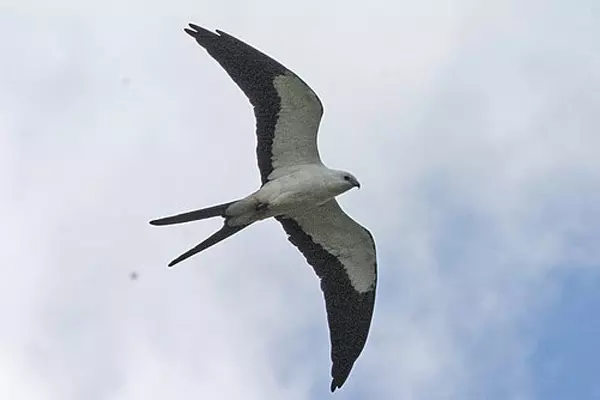
- Scientific name: Elanoides forficatus
- Lifespan: 6 years
- Wingspan: 4 ft
- Range: United States
Swallow-tailed kites are striking birds of prey with a black-and-white appearance. Their defining feature is the deeply forked tail, which resembles a “V.” 18th-century English naturalist Mark Catesby named them “forked-tail hawk” because of this tail shape.
These kites are carnivores, dining on insects, frogs, anoles, and snakes. They spend their fall and winter in South America, migrating to Florida in the spring for breeding.
While they once inhabited the southeastern United States, today, they’re mainly seen in Florida’s swamps, marshes, and large rivers.
Swallow-tailed kites currently mostly inhabit seven southeastern states: Florida, South Carolina, Georgia, Alabama, Mississippi, Louisiana, and Texas.
2. Red Kite

- Scientific name: Milvus milvus
- Lifespan: 10 years
- Wingspan: 5 ft
- Range: Europe
Red kites are medium-sized birds of prey with long, red and pale forked tails. They’re the largest kites with grey heads and yellow beaks. Thanks to their split tails, they’re agile fliers, staying airborne for hours.
They live in Spain, Portugal, central Europe, Ukraine, southern Sweden, Latvia, the UK, and southern Italy. In winter, they migrate like swallow-tailed kites.
Red kites form lifelong pairs but may separate or roost together in winter. They’re carnivores, eating mice, voles, hares, rabbits, birds, reptiles, and amphibians. Their forked tails act like a rudder for steering.
3. Bahama Swallow

- Scientific name: Tachycineta cyaneoviridis
- Lifespan: n/a
- Wingspan: 15 in
- Range: Bahamas
Bahama swallows are medium-sized with white bellies, dark blue/green backs, and steel-blue wings. They’re endangered and have deeply forked tails. Young ones resemble juvenile tree swallows with less forked tails.
They inhabit Andros Island in the Bahamas, residing in fields and forests. These insect-eating birds swiftly catch small flying prey.
4. Tree Swallow

- Scientific name: Tachycineta bicolor
- Lifespan: 3 years
- Wingspan: 12-14 in
- Range: United States and Canada
Tree swallows are small migratory songbirds with long, pointed wings and short, squared, or slightly notched tails.
Tree swallows breed in the United States and Canada – they begin migrating south in July and August to western Mexico and Central America. They are social animals with flocks of thousands of birds. Tree swallows are omnivores that feed on insects, mollusks, spiders, and occasionally on fruit, berries, and seeds.
You can see them in Florida, Tennessee, Kansas, Missouri, Ohio, and similar.
5. Barn Swallow

- Scientific name: Hirundo rustica
- Lifespan: 4 years
- Wingspan: 12.5-13.5 in
- Range: Europe, Asia, Africa, and the Americas
The barn swallow is the most widespread species of swallow in the world. It has a blue head and wings, rusty-orange throat and forehead, and a pale orange chest and underside. Barn swallows are distinguished for their long, slender, and deeply forked tails. Males and females look similar – the female’s tail is a little less forked.
According to legend, the Barn Swallow got its forked tail because it stole fire from the gods and brought it to people. This made the gods angry so they threw a firebrand at the swallow, burning its middle tail feathers.
Check this YouTube video to see what their tails look like when sitting perched or in flight.
The barn swallow is one of the largest swallow species found in Maryland and Pennsylvania. Although rare in the states in late fall and winter, you will be able to spot it as it comes back around late March.
6. Royal Tern
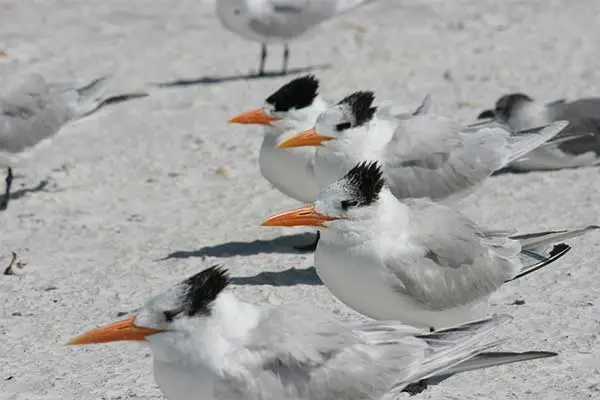
- Scientific name: Thalasseus maximus
- Lifespan: up to 30 years
- Wingspan: 40-50 in
- Range: North America, South America, West Africa
The royal tern is the second-largest tern, found on warm saltwater coasts. It’s gray below, white above, with a black crest and an orange bill. Their legs are short, and tails moderately forked.
There are two subspecies: one in the Americas, and the other in West Africa. They are medium-distance migrants, with North American terns flying to Peru, Uruguay, and Argentina.
Royal terns are carnivores, dining on small fish, shrimp, and crustaceans. A group of them is called a “highness.”
Read More: Birds with incredible-looking orange bills
7. Arctic Tern

- Scientific name: Sterna paradisaea
- Lifespan: 15-30 years
- Wingspan: 25-30 in
- Range: Antarctic, North America, Europe, and Asia
The Arctic tern is a small, slender gray-and-white bird with narrow wings, short legs, and a black cap. Its long and deeply forked tail is white with grey outer webs.
This tern is a small but mighty flier, well known for its long-distance migrations. Arctic terns migrate from pole to pole, traveling over 25,000 miles each year. They might also visit Hawaii.
8. Fork-tailed Drongo
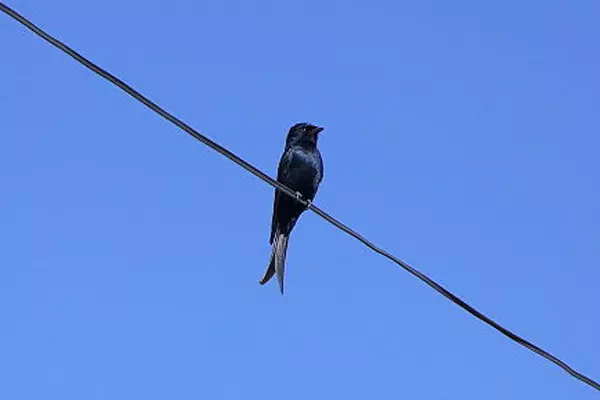
- Scientific name: Dicrurus adsimilis
- Lifespan: 15 years
- Wingspan: n/a
- Range: Africa
Fork-tailed drongos are medium-sized birds with black plumage, red eyes, and distinctive forked tails.
What is interesting about these birds is that they are kleptoparasites.
This means that most of the time, they will follow other animals, and genuinely warn them when they spot a predator. However, sometimes drongos will make false alarms when other animals find food. Those scared animals will run away and drongos will feast on their catch. They mostly rob birds like pied babblers and animals such as meerkats.
Drongos are very aggressive towards large predators who roam around their area – they will mob, harass, and peck raptors, forcing them to move out of their territory.
9. Common House Martin

- Scientific name: Delichon urbicum
- Lifespan: 5 years
- Wingspan: 11 in
- Range: Africa, Europe, and Asia
The common house martin, a small migratory bird, has a dark blue mantle and crown, gray wings, a moderately forked tail, and white underparts. Their tails are shorter than swallows’ and lack long streamers.
These birds head to sub-Saharan Africa and tropical Asia for winter and stay in Europe and Asia from April to October. They’re insectivores, catching flies, aphids, and flying ants in mid-air.
10. House Sparrow

- Scientific name: Passer domesticus
- Lifespan: 3-5 years
- Wingspan: 9 in
- Range: Asia, North Africa, and Europe
The house sparrow is a small bird with a gray head, white cheeks, a black bib, and a reddish-brown neck. Its tail has a small split.
These birds enjoy dust baths and have their own favorite spots. They toss soil and dust over their feathers, defending these spots.
House sparrows are the most widely distributed wild birds, with some living up to 23 years in captivity. They are also common backyard birds of Central Texas and North Texas.
11. Fork-tailed Flycatcher

- Scientific name: Tyrannus savana
- Lifespan: 5-10 years
- Wingspan: 6-15 in
- Range: Mexico and Argentina
The fork-tailed flycatcher is a passerine bird with a black cap, white color below, and gray above. It got its name from the distinguishingly long, forked tail. It is a bird with one of the longest tails on the North American continent.
Fork-tailed flycatchers are some of the fastest birds, reaching speeds of 65 mph. What gives them an edge in flight and allows them to make sharp twists and turns in the air are their long tail feathers.
Most are migratory birds, but some stay the entire year, especially those in southern Mexico. Those that do, migrate two times a year.
12. Pacific Swift
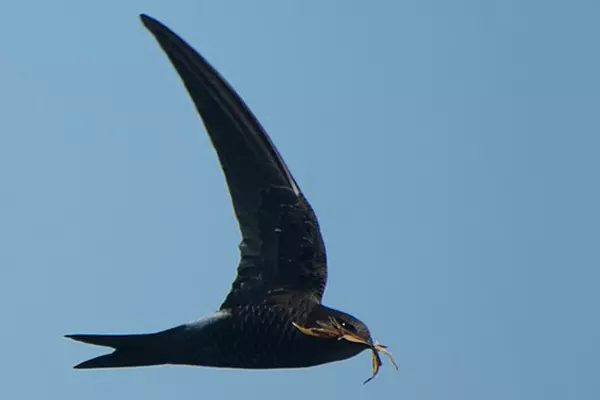
- Scientific name: Apus pacificus
- Lifespan: n/a
- Wingspan: 17-21 in
- Range: Australia and Asia
The Pacific swift, also known as a fork-tailed swift, is a highly aerial bird with pointed wings, dark plumage, and a deeply forked tail.
Swifts, just like martins, have similar-looking tails. The Pacific swift will sometimes hold its tail folded. That way, the fork disappears and resembles a long spike.
They are insectivores and feed on termites, moths, wasps, bees, and flies. They are migratory species that fly to Southeast Asia and Australia. Pacific swifts are rather small black birds with split tails that will spend most of their time in the air, rarely getting down to the ground.
13. Gilded Flicker
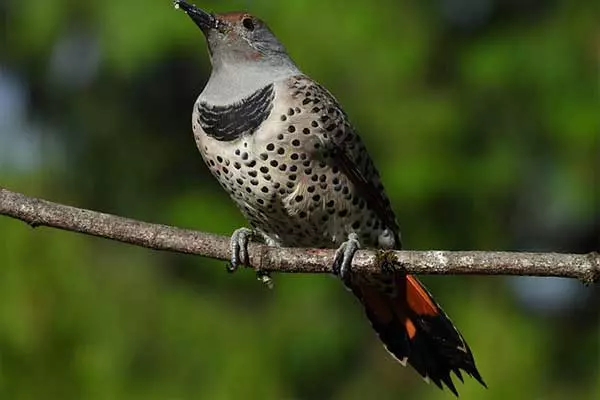
- Scientific name: Colaptes chrysoides
- Lifespan: n/a
- Wingspan: 18 in
- Range: California, Arizona, and southwestern Mexico
The gilded flicker is a large-sized woodpecker with a large black crescent on the chest, dots on the breast, a barred back, and a brownish crown. It is yellow under the tail and wings and has a shallowly forked tail. They are quite similar to Northern flickers which have a red color under their tails (like the one in the photo).
14. Ashy Storm-petrel

- Scientific name: Oceanodroma homochroa
- Lifespan: 25 years
- Wingspan: 18 in
- Range: California
Ashy storm-petrel is a small seabird with a long and forked tail. Its body has a light gray color, while the wings have dark and light gray patterns.
They are migratory birds and can live a long life – up to 34 years! Ashy storm petrels stay with the same mate for many years and nest in the same burrow.
15. Great Frigatebird

- Scientific name: Fregata minor
- Lifespan: 30-34 years
- Wingspan: 80-90 in
- Range: Coasts of America, the Caribbean Sea, and Cape Verde
The great frigatebird is a large seabird with black plumage, long, slender wings, and a deeply forked tail. The tail may appear pointed when folded. Male great frigatebirds are smaller than females.
They will often steal fish and other food from other seabirds. Great frigatebirds are migratory.
Male frigatebirds belong to a group of birds with red necks because of the inflatable throat pouches they use to seduce females during the breeding season.
16. Pin-tailed Whydah

- Scientific name: Vidua macroura
- Lifespan: 12 years
- Wingspan: n/a
- Range: Sub-Saharan Africa and Puerto Rico
The Pin-tailed whydah is a small songbird with a red bill, black back, and crown. Breeding males have striking, long, pennant-like tails. However, in winter, they lose their bright colors and long tails.
They are brood parasites, laying their eggs in the nests of other bird species and providing no parental care.
17. Lilac-breasted Roller

- Scientific name: Coracias caudatus
- Lifespan: 10 years
- Wingspan: 20-23 in
- Range: Eastern and Southern Africa
The lilac-breasted roller, an African bird, dazzles with its colorful appearance. It boasts a lilac breast, turquoise underside, reddish-brown wings, and a deeply forked turquoise tail with black streamers.
These birds are monogamous, forming lifelong pairs, and both males and females share parental responsibilities. They’re also known for their acrobatic displays during the breeding season.
Read More: Black Colored Birds With White Patches
18. Sabine’s Gull

- Scientific name: Xema sabini
- Lifespan: 8 years
- Wingspan: 33-36 in
- Range: North America, Arctic, north-western coast of Africa, and Greenland
Sabine’s gull, also known as the fork-tailed gull, is a small bird with a gray head, a black edge around it, and a black bill with a yellow tip. It has long, pointed wings and a shallowly forked tail.
19. American Goldfinch
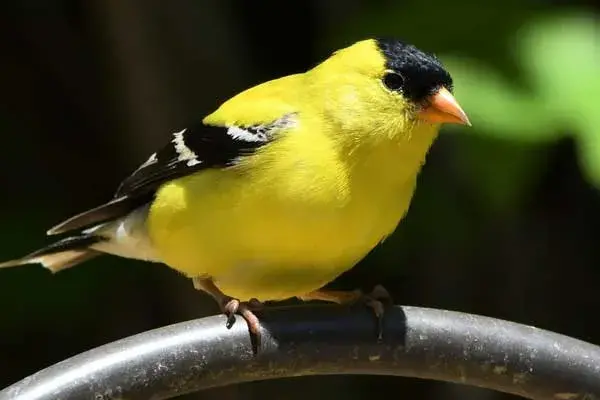
- Scientific name: Spinus tristis
- Lifespan: 3-6 years
- Wingspan: 7.5-8.7 in
- Range: North America
The American goldfinch is a small migratory bird with a small head, short, slightly notched tail, and long wings with a single white stripe.
During breeding, both male and female goldfinches have colorful orange bills, which indicate their health. A more vibrant bill means higher testosterone levels, reducing physical conflicts and energy loss.
They molt twice yearly, in late winter and late summer. These birds are the state birds of New Jersey, Iowa, and Washington.
20. Purple Martin
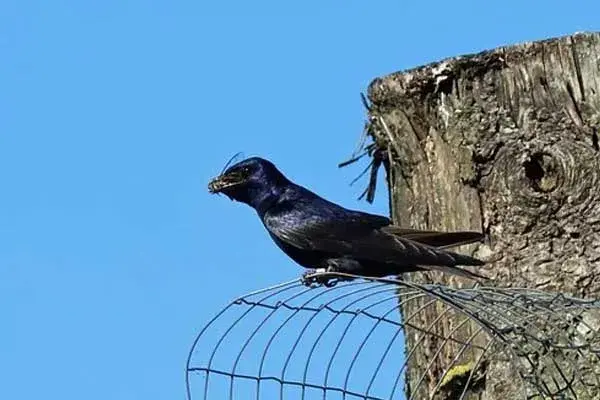
- Scientific name: Progne subis
- Lifespan: 5-7 years
- Wingspan: 15 in
- Range: North America
Purple Martins, North America’s largest swallows, boast a short forked tail and long tapered wings.
Adult males sport a dark hue with a purplish-blue shimmer. Their head can look royal blue, navy blue, deep purple, or green depending on the light.
They can form large colonies of over 700,000 birds! These birds are excellent fliers, capable of speeds over 40 mph.
21. Green-crowned Woodnymph

- Scientific name: Thalurania fannyi
- Lifespan: n/a
- Wingspan: n/a
- Range: South America
Green-crowned woodnymphs are South American hummingbirds found in lush forests near streams.
Males sport green plumage with a shimmering head, throat, and breast. Their tail is dark blue and deeply forked.
These birds, from Belize to northern Peru, sip nectar from colorful flowers. They’re polygynous, with males and females having multiple partners. Males will not participate in choosing the nest location, building the nest, or raising the chicks.
Read More: List of green-colored small birds
22. Fork-tailed Storm Petrel

- Scientific name: Oceanodroma furcata
- Lifespan: up to 25 years
- Wingspan: 18.1 in
- Range: North America and Asia
Fork-tailed storm petrels are striking silvery-blue seabirds that live in the North Pacific Ocean. They’re found in northern California, Oregon, Washington, British Columbia, Alaska, and northeast Asia.
These birds fly low over the water and use their forked tails to catch fish and crustaceans, relying on their keen sense of smell for hunting.
Their forked tails are most noticeable during flight, adding to their beauty.
They have a unique defense mechanism – they store oil in their stomach to deter predators and feed their chicks. Plus, they lay relatively large eggs, about 20% of their body weight.
23. Black-headed Bunting

- Scientific name: Emberiza melanocephala
- Lifespan: up to 11 years in the wild
- Wingspan: n/a
- Range: Europe and Asia
Black-headed buntings are stout birds found in open scrublands. They have a long, slightly forked, brown-gray tail and a relatively long bill.
Males boast vivid yellow undersides, chestnut upper parts, and black heads. Females are paler, with gray-brown backs and grayish heads.
In winter, they migrate to Asia, covering over 4,300 miles.
24. Black-chinned Hummingbird
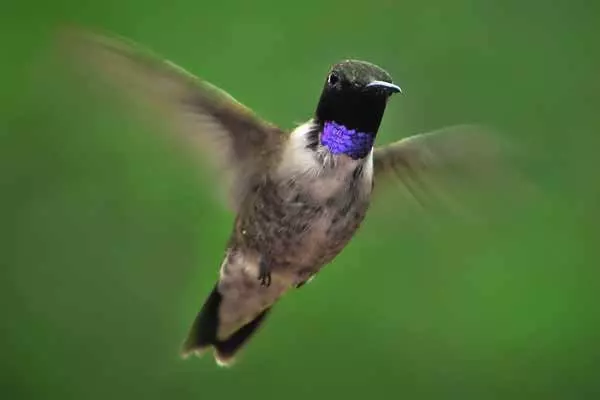
- Scientific name: Archilochus alexandri
- Lifespan: up to 10 years
- Wingspan: 1.5-1.9 in
- Range: North America
Black-chinned hummingbird is a tiny, migratory bird with shiny green upperparts and white undersides. It features a slender beak and a dark forked tail. Males sport black faces, chins, and purple throat bands.
During cold weather, these birds can consume up to three times their body weight in nectar in a day.
You’ll spot them in the western United States, reaching from Canada’s Alberta and British Columbia down to Mexico. They inhabit mountains, woodlands, orchards, and meadows.
Read More: 5 beautiful species of loons in Canada
As part of their courting rituals, males will make broad U-shaped dives 60-100 feet past a perched female. However, outside the breeding season, they are mostly solitary birds.
25. Sandwich Tern
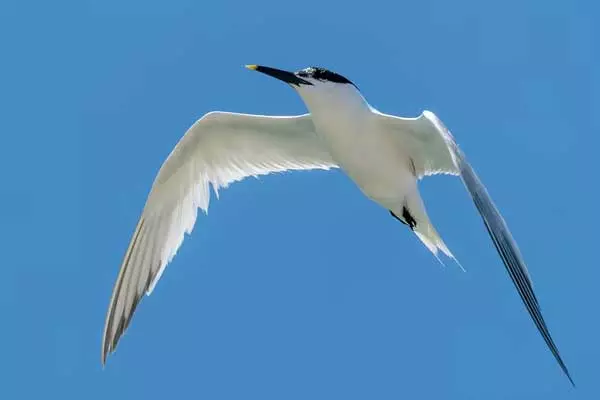
- Scientific name: Thalasseus sandvicensis
- Lifespan: 18-22 years
- Wingspan: 33-38 in
- Range: Europe, Asia, Africa, South, and North America
Sandwich terns have split tails, grey upperparts, white underparts, and shaggy black crests. They are medium-sized birds with thin yellow-tipped black beaks and long wings. Both sexes look alike.
They use their forked tails for agile flight and plunge-diving into water for fish. This behavior is part of their courtship display.
The name “Sandwich tern” originates from the town of Sandwich in the United Kingdom, where it was first described in 1787.
26. Couch’s kingbird

- Scientific name: Tyrannus couchii
- Lifespan: n/a
- Wingspan: 16 in
- Range: North and Central America
Couch’s kingbirds, found in southern Texas during the summer, are large flycatchers near woodlands, ponds, and rivers.
They have yellow breasts, pale gray heads, and slightly forked tails. Dark beaks and legs complete their stunning look.
Named after soldier-naturalist Darius N. Couch, they closely resemble tropical kingbirds and were thought to be the same species until the 1960s.
27. Ruby-throated Hummingbird
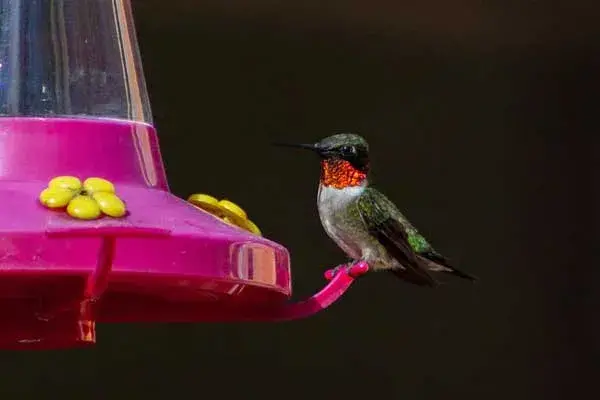
- Scientific name: Archilochus colubris
- Lifespan: 3-5 years
- Wingspan: 3.1-4.3 in
- Range: North and Central America
Ruby-throated hummingbirds, common in the eastern US and Canada, are sexually dimorphic.
Males are emerald green with ruby-red gorgets, moderately forked tails, and black wings. Females are larger with shorter beaks and white throats.
They’re fast flyers, reaching 25 mph with over 50 wing beats per second. Remarkably, they have just about 940 feathers, the fewest of any bird.
Mostly solitary except during a brief breeding season, you can attract them with feeders or tubular flowers in your backyard. They’re bold and may feed near your porch or windows!
28. White Tern

- Scientific name: Gygis alba
- Lifespan: up to 42 years
- Wingspan: 30–34 in
- Range: North America, Central America, Australia, and Asia
The white tern, also called the white fairy tern, is a small seabird with all-white feathers, a slightly forked tail, and a black bill with a blue base.
Found in Hawaii, it’s known as “manu-o-Kū,” translating to “the bird of Ku,” named after the Hawaiian god of war, Ku.
In the past, sailors used white terns to find land; they fly to sea in the morning to feed and return at night.
Officially, the white tern has been the bird of Honolulu since 2007.
Read More: 18+ examples of beautiful white birds of Hawaii
29. Buff-bellied Hummingbird
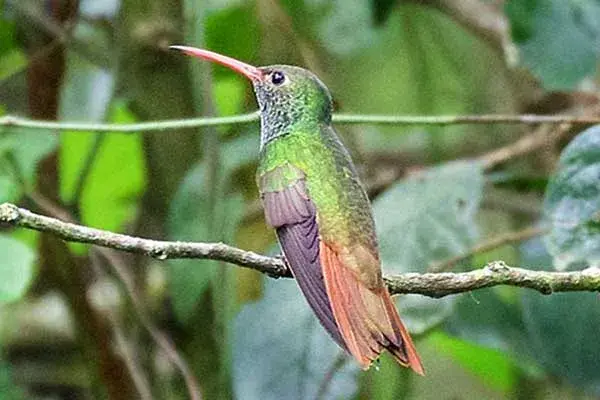
- Scientific name: Amazilia yucatanensis
- Lifespan: up to 11 years
- Wingspan: 5.75 in
- Range: USA and Mexico
Buff-bellied hummingbirds are rare winter visitors to the Florida panhandle.
Medium-sized and easy to spot with metallic olive green feathers, red bills, slightly forked tails, and buffy belly patches, they also have metallic golden-green throats.
You can find them around hummingbird feeders, where they chase off smaller birds, as they feed on nectar and insects.
These birds prefer pine-oak forests, scrub, and watercourse thickets. Females build nests in shrubs and trees, laying two white eggs. Both males and females fiercely guard their feeding spots.
30. Caspian Tern

- Scientific name: Hydroprogne caspia
- Lifespan: 12 years
- Wingspan: 50–57 in
- Range: Widespread
The Caspian tern, the world’s largest tern, is found on nearly every continent. Recognizable by its large size, coral red beak, shallowly split tail, and raucous call, it is white with pale gray upperwings.
Named after the Caspian Sea, where they are still common, Caspian terns are fiercely protective of their breeding colonies, chasing away threats and even biting intruders.
They hover high over the water, hunting fish, and occasionally dine on large insects, other birds’ young, eggs, and some rodents.
31. Magnificent Frigatebird
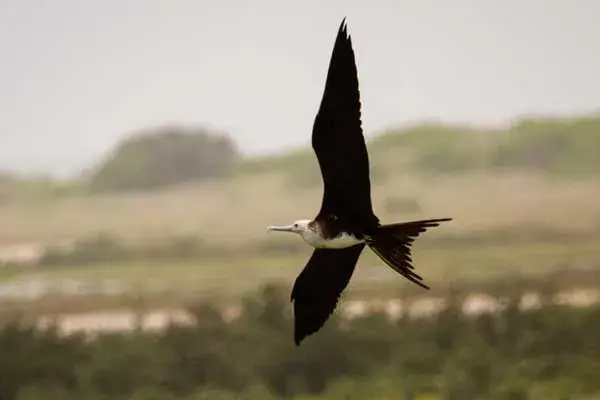
- Scientific name: Fregata magnificens
- Lifespan: 14-30 years
- Wingspan: 85.4-96 in
- Range: North, Central, and South America, Europe, and Africa
Rightfully named due to their striking appearance and behavior, magnificent frigatebirds are easily recognizable even at long distances. In North America, you can spot them in Florida.
These birds are large with long wings and deeply forked tails. Males use a red gular sac to woo females.
They’re known for stealing fish through harassment, forcing them to regurgitate their meal and then catch it mid-air. Despite their massive wingspan, they can’t land on water because their feathers aren’t waterproof.
32. Anna’s Hummingbird
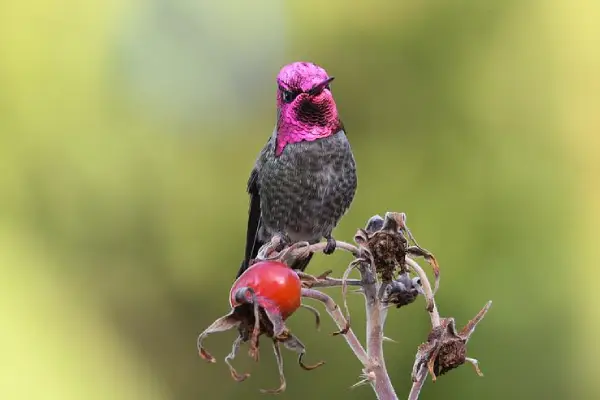
- Scientific name: Calypte anna
- Lifespan: 8.5 years
- Wingspan: 4.7 in
- Range: North America
Anna’s hummingbirds are named after the Duchess of Rivoli, Anna Masséna.
Medium-sized and stocky, they have split tails and iridescent bronze-green backs. Males boast reddish-pink heads and throats extending to their necks, while females have grayish bodies with green heads and some throat red.
These birds use their long tongues to feed on flower nectar and catch insects in flight.
Once limited to northern Baja California and southern California in the early 20th century, they’ve expanded their breeding range. Scientists estimate their population to be around 1.5 million individuals.
33. Lesser Nighthawk

- Scientific name: Chordeiles acutipennis
- Lifespan: 4-5 years
- Wingspan: 21.5 in
- Range: Central, North, and South America
Lesser nighthawks are small birds with rounded wings and long notched tails, often spotted flying low over deserts and grasslands at dusk.
Their “earthy” plumage camouflages them, but a distinctive bar across the wingtips is visible in flight, white in males and cream-colored in females.
They resemble common nighthawks but can be told apart by the position of the white wing patch.
Known for their bat-like flying, they breed across several U.S. states and Mexico. Females lay eggs on the ground, using camouflage.
34. Chipping Sparrow
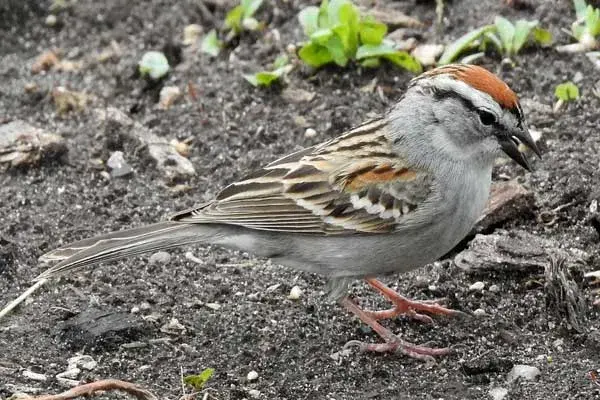
- Scientific name: Spizella passerina
- Lifespan: up to 9 years
- Wingspan: 8-9 in
- Range: North America
The chipping sparrow, a common North American garden bird, features dusky eyebrows and dark eye-lines, which turn almost white during breeding.
Delicate and active with slightly notched tails, they boast bright chestnut crowns in the breeding season.
Their nest-building skills are subpar, often with little insulation for eggs. There are two subspecies, the eastern and western chipping sparrows.
Read More: Sparrows that have red heads
35. House Finch

- Scientific name: Haemorhous mexicanus
- Lifespan: up to 11 years
- Wingspan: 8-10 in
- Range: North America
House finches are common backyard birds found throughout North America in various habitats. They have conical bills, short wings, and shallowly notched tails.
Males sport brown plumage, streaked underparts, and red accents on their heads, breasts, eyebrows, and rumps.
The red hues in male house finches come from their diet. Females prefer mates with the reddest faces.
House finches sing differently depending on their location. They vary from short Californian songs to longer, more complex ones in Wisconsin and Colorado.
Estimates suggest a wide population range, from 267 million to 1.7 billion individuals across the continent.
36. Carolina Chickadee
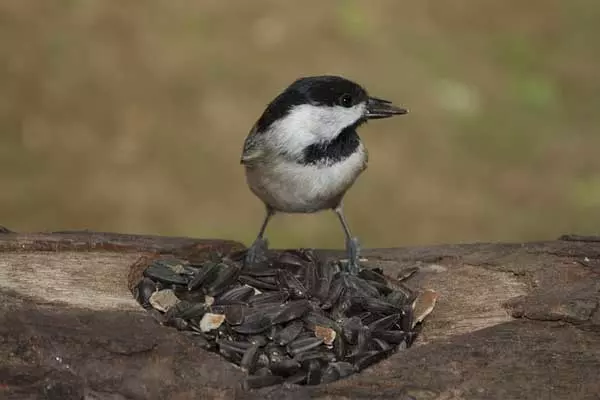
- Scientific name: Poecile carolinensis
- Lifespan: up to 10 years
- Wingspan: 6-8 in
- Range: North America
Carolina chickadees are small birds with black caps and bibs, white cheeks, gray backs, and white underparts. They have short, dark beaks, short wings, and moderately long, shallowly forked tails.
In extreme cold, they enter torpor, a deep sleep that lowers body temperature, heart rate, and metabolic rate, helping them survive the winter.
37. Varied Bunting

- Scientific name: Passerina versicolor
- Lifespan: n/a
- Wingspan: 8.3 in
- Range: North America
Varied buntings reveal their dazzling colors up close, despite appearing dull from afar.
Males display deep red plumage, violet-blue faces, rumps, and shoulders, along with red napes and arcs behind the eyes. In contrast, females have simple light brown feathers.
These small songbirds feature shallowly forked tails and short, conical beaks.
Unlike many songbirds, varied buntings lay eggs of different colors, either green or blue.
38. Purple Finch
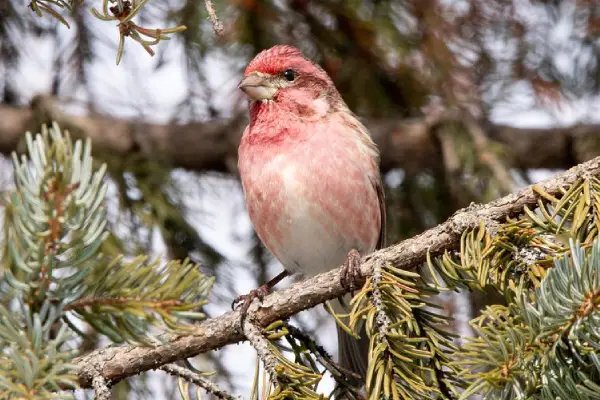
- Scientific name: Haemorhous purpureus
- Lifespan: 3-4 years
- Wingspan: 9.8 in
- Range: North America
Despite the name, purple finches aren’t purple. Males have pink-reddish heads, breasts, backs, rumps, and streaked backs. Females are light brown above and white below and have a white line on the face above the eye.
These small birds also have short forked brown tails and brown wings.
Final Thoughts
This concludes our list of birds with forked tails.
There are plenty of bird species with forked (split) tails including kites, terns, storm petrels, swallows, and others. Some of them have a very distinct v-shape of their tails, while others have less prominent ones.
Read more: Animals that very much resemble meerkats